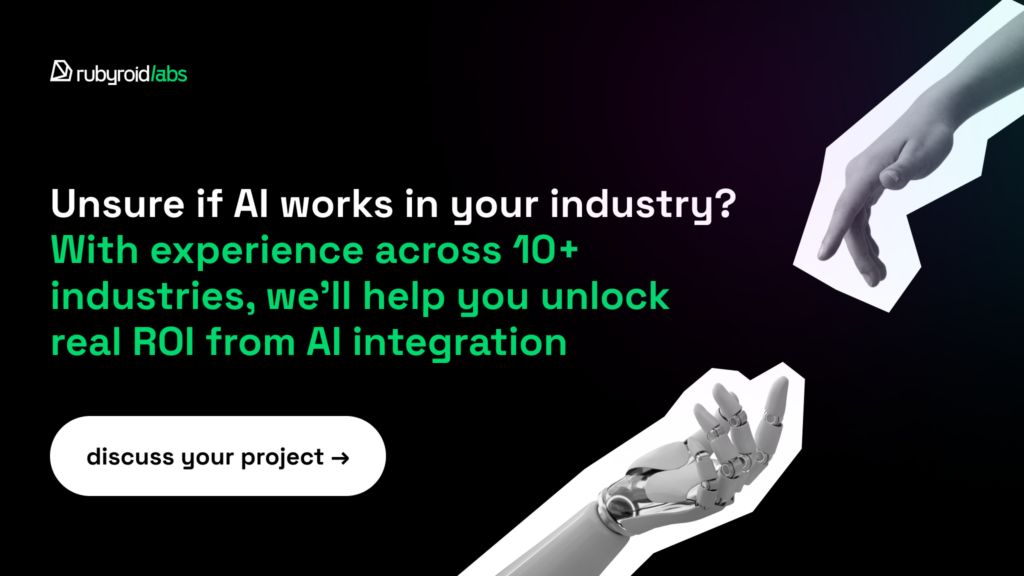AI has been riding a massive wave of attention ever since OpenAI’s ChatGPT made headlines. Everyone’s talking about it, experimenting with it, or trying to figure out if it’s just another overhyped trend.
However, when it comes to real decisions whether to integrate AI into a project, one of the top questions business owners ask is
“If I invest in AI now, how will I see a return, especially if the results are so hard to measure?”
Well, it’s a fair concern. With traditional app development, you can estimate the cost, build the product, and track the results. But with AI, the path isn’t always that clear. The return on investment (ROI) can feel… invisible. That’s why some business owners are worried about whether AI is a media-fueled bubble or a genuinely transformative technology.
With AI in app development, the stakes are even higher. Should you integrate AI into your product? Build something from scratch? Or wait and watch your competitors leave you behind?
In this post, we’ll dive into how to measure AI ROI, when AI is worth investing in, and when artificial intelligence can spoil an application.
Contents:
- Why ROI from AI Is Hard to Measure
- How to Measure ROI on AI: a Practical Guide
- When to Invest in AI
- Best Examples of High-ROI AI-Powered Applications
- When Is Investing in AI a Bad Idea?
- Tips to Keep in Mind Before Investing in AI
- Conclusion
Why ROI from AI Is Hard to Measure
If you’re considering investing in AI, you’ve likely discovered that predicting its success isn’t as straightforward as you’d hoped.
AI often promises big returns, but unlike traditional tech investments, its results aren’t exactly straightforward. So, what’s going on here?
First of all, let’s clear up a common misunderstanding: AI isn’t a “set it and forget it” type of solution. You cannot plug it in once and wait for miracles to happen. In reality, AI projects require continuous fine-tuning, updates, and maintenance. This ongoing attention means ongoing costs both in time and money that teams often overlook when initially estimating ROI.
Beyond the initial price tag, here are the often-overlooked cost factors that make AI ROI difficult to measure:

1. Integration Challenges
Your shiny new AI tool might not work seamlessly with your existing systems. Getting all your tech to communicate properly can take significant time and effort. Integration headaches can burn through your budget and team resources faster than expected.
2. Team Training and Adoption
AI tools may be powerful but only if your people know how to use them. Training your team to fully adopt and leverage AI systems takes time, education, and support. This learning curve often delays the realization of ROI.
3. Data Preparation and Model Training
AI models rely on high-quality data. Collecting, cleaning, labeling, and managing that data is no small task. It’s often expensive, time-consuming, and underestimated. Without well-prepared data, your AI model won’t perform, and your ROI will suffer.
4. Infrastructure Costs
Running AI at scale isn’t cheap. Whether it’s cloud computing power or specialized hardware, infrastructure needs can quickly inflate your spending. These hidden costs can quietly chip away at what initially looked like a promising investment.
5. Delayed Payoffs
AI doesn’t always deliver instant results. While you might see early wins like automating repetitive tasks, larger gains like customer insights, predictive analytics, or strategic decision-making typically unfold over months or even years. This time lag makes it tough to tie results directly back to your investment.
So, does all of this mean the ROI of AI is impossible to measure? Not at all. It’s just more complex than traditional metrics. Let’s look at how you can approach it effectively.
How to Measure ROI on AI: A Practical Guide
Measuring the return on your AI return on investment doesn’t have to be guesswork. By breaking down the process into manageable steps, clearly defining your metrics, and understanding the differences between hard and soft returns, you’ll be better equipped to gauge the true impact of AI on your business.
Is AI integration worth the cost and how to measure AI return on investment?
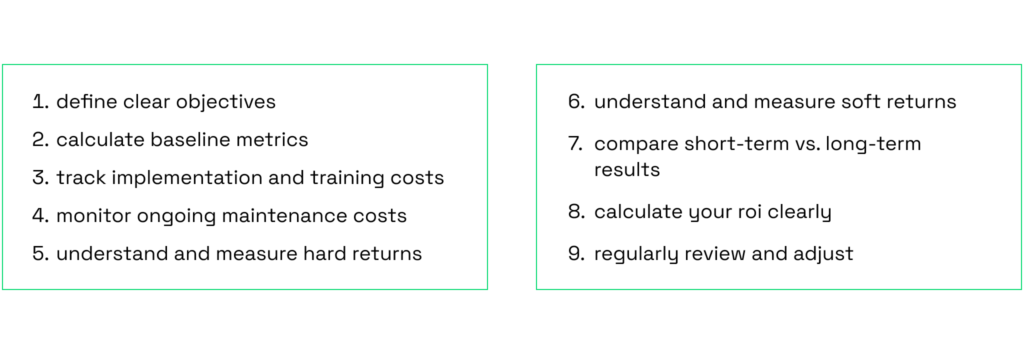
Step-by-Step Approach:
1. Define Clear Objectives
Clearly state specific goals and business problems or opportunities that AI assistance will address.
Establish clear, measurable KPI indicators tied directly to these goals.
2. Calculate Baseline Metrics
Record the existing metrics and performance level that will serve you as pre-AI metrics for future comparison.
3. Track Implementation and Training Costs
Consider all the investments that are involved in AI implementation. For example, software licenses, hardware upgrades, data preparation, integration, and initial training.
4. Monitor Ongoing Maintenance Costs
Recurring expenses include cloud computing, regular model updates, data storage, and ongoing training.
5. Understand and Measure Hard Returns
“Hard returns” are direct, tangible, and easily measurable financial benefits. They typically include:
- Increased revenue when sales uplift is directly attributable to AI-driven recommendations or customer targeting.
- Cost savings from automating manual tasks, resulting in fewer labor hours or reduced error rates.
- Productivity gains are when there are concrete improvements in the efficiency or speed of tasks.

6. Understand and Measure Soft Returns
“Soft returns” are indirect or intangible benefits that, although harder to quantify, are crucial for long-term value. Examples include:
- Customer satisfaction: Improved user experience leading to higher customer retention rates.
- Employee morale: Reduced tedious work leading to increased employee engagement and retention.
- Better decision-making: Enhanced analytics and insights help your team make smarter strategic choices.
How to track soft returns:
– Surveys and feedback. Regular employee and customer satisfaction surveys, Net Promoter Scores (NPS).
– Retention and engagement rates. Monitor changes in customer retention, churn rates, and employee retention and productivity.
7. Compare Short-Term vs. Long-Term Results
Short-term gains typically include immediate hard returns, such as increased process efficiency or direct cost savings.
Long-term gains usually involve soft returns, strategic advantages, and competitive differentiation that become clear over extended periods.
8. Calculate Your ROI Clearly
The general formula for how to calculate ROI of AI in apps is as follows:

Hard returns can be directly measured.
Soft returns may require estimates or proxy measurements tailored to your business.
9. Regularly Review and Adjust
Continuously track and adjust your metrics, refining your understanding of both hard and soft returns as your AI strategy evolves.
However, keep in mind that all metrics, calculations, and success rates can vary significantly depending on factors such as the industry, application complexity, developer expertise, and many other variables.
If you’re curious about investing in AI but aren’t sure where to start, we can help. As one of the top generative AI development companies, we offer expert AI integration services and can walk you through the numbers to help you implement AI into your project.

When to Invest in AI
Deciding to bring AI into your business can feel like stepping into unknown territory. Jump in too early, and you risk investing significant resources before your company is ready. Wait too long, and you might lose out on competitive advantages or efficiency gains.
So, where is the sweet spot in the benefits of AI in software development and how can you reach it?
Let’s figure out this question by exploring some clear signs of when to use AI in app development.
How Do You Know Your Business Is Ready for AI?
Not every business is ready to get benefits from AI immediately. Here are some clear indicators when it’s time to integrate this tech solution. You can use them for creating a better AI business strategy.

- Data Maturity
You have access to large volumes of structured (and possibly unstructured) data and, more importantly, you know how to manage it. AI models are only as good as the data they learn from. - Leadership Buy-In
Senior decision-makers understand the value of AI and are committed to long-term investment. Without leadership support, AI initiatives often stall or become siloed. - Clear Business Cases
You’ve identified specific problems or opportunities where AI can deliver measurable value like reducing costs, improving customer experiences, or automating repetitive tasks. For example, AI has greatly shaped e-commerce. In our article you can learn how ChatGPT can be used in different e-commerce sectors. - Technical Infrastructure
Make sure you have all the necessary tech for AI investment. Implementation of artificial intelligence needs a healthy digital ecosystem, the right cloud, data pipelines, and API systems in place or a plan to build them. AI doesn’t live in a vacuum. - Change-Ready Culture
Your teams are open to innovation, experimentation, and learning. AI adoption often requires shifting workflows and mindsets.
Considering all these factors will position your business for successful implementation of artificial intelligence and set the stage for meaningful, measurable outcomes.
Best Examples of High-ROI AI-Powered Applications
Whether it’s a media-fueled bubble or not, we, though, can clearly see how AI has changed and accelerated our approach to both work and life. For example, you don’t even need the paid version of ChatGPT to experience how writing an email now takes just a couple of minutes, unlike before.
In this way, AI has shaped many industries by delivering high ROI through streamlined processes, enhanced decision-making, and improved user experiences. Here are some real examples of AI ROI in software where the technology has shown the greatest impact:
Finance
In finance, AI has automated many operations, including automating trading, detecting fraud in real time, and powering personalized financial advice. Algorithms can analyze massive datasets instantly, helping banks and fintechs reduce risk and improve decision-making.
For example, Cleo, a financial AI assistant, can analyze your spending, set budgets, and offer financial advice in a conversational tone. It can even roast you for overspending to keep you accountable, making personal finance feel more engaging and relatable.

Insurance
AI enables insurers to automate claims processing, assess risk more accurately, and detect fraudulent activity. Moreover, a well-trained assistant can advise on insurance options and suggest improvements to policies and insurance conditions.
Just like our client’s project CoverageXpert does. The smart assistant helps insurers and brokers select the most suitable insurance programs from over 700 policy forms and more than 33,000 coverage enhancements offered by 50 top insurance companies. It improves service quality and speeds up the process of finding the right solutions.

Marketing
AI helps deliver hyper-personalized content, optimize ad spend, and predict customer behavior. It also excels at brainstorming ideas for marketing strategies and improving campaign targeting.
Thus, marketers use Jasper to speed up content production, maintain brand voice, and scale campaigns across platforms like Google Ads, Facebook, and email. This AI assistant generates high-quality marketing copy, blog posts, product descriptions, email content, and ad copy in seconds.
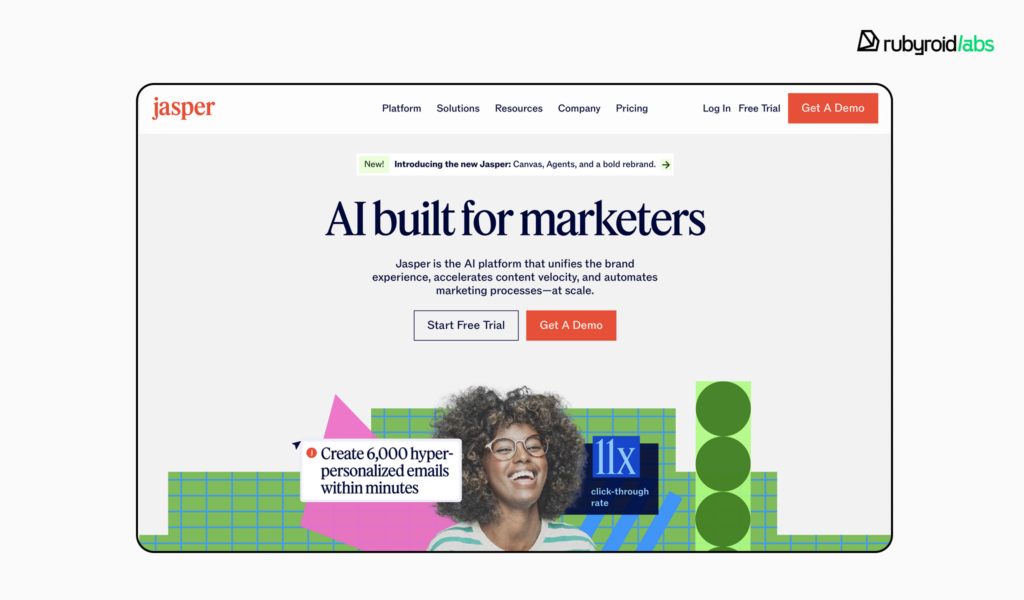
E-Learning
AI-powered platforms help personalize learning paths based on student performance and preferences. They provide instant feedback, adaptive quizzes, and insights that help educators and learners improve outcomes.
Using Magoosh, students can prepare for essential international tests such as the GRE, LSAT, TOEFL, IELTS, and more. The AI tutor checks essays, answers subject-related questions, suggests improvements, and provides explanations, which greatly improves the quality of learning.
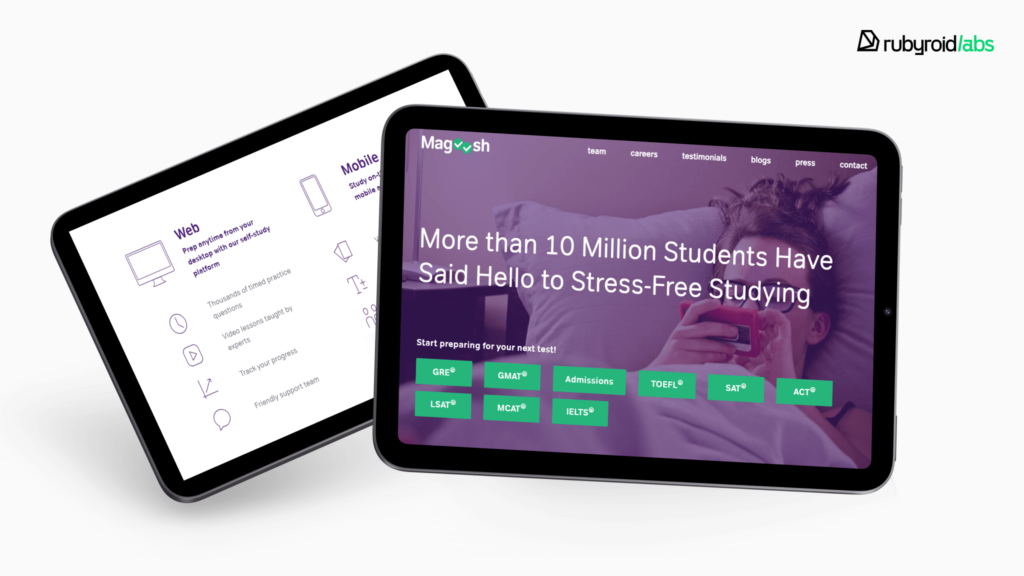
You can find more information about AI in education in our blog post, where we highlight all hidden benefits and drawbacks of using the technology.
Customer Service
AI-driven customer service chatbots and virtual assistants efficiently handle a large volume of customer inquiries, providing instant responses around the clock. This reduces wait times, boosts customer satisfaction, and frees up human agents to focus on more complex issues.
Amazon’s AI-driven virtual assistant Alexa helps customers track orders, manage returns, and get quick answers through voice or text. The system can handle most queries instantly, escalating to human agents only when needed. This streamlines support, improves customer satisfaction, and reduces operational costs.

As you can see, artificial intelligence can bring numerous benefits for businesses. Implementing smart technology gives you at minimum a significant advantage over competitors, and at best, leads to greater user engagement and customer satisfaction.
AI is evolving. With each update, its capabilities grow, the ‘mind’ becomes sharper, and its skills get more sophisticated. Soon, we expect the release of GPT-5 to support businesses with advanced features such as agent capabilities, multimodality, and improved reliability.

When Is Investing in AI a Bad Idea?
If you’re feeling inspired by the earlier examples of AI integration, that’s great. But don’t assume AI is the perfect solution for every industry or problem. While it’s one of today’s most talked-about technologies, there are situations where the ROI can be, let’s say, easily overestimated.
Thanks to their broad experience integrating AI across industries from insurance to sports and fitness, our developers have been able to pinpoint the use cases where AI is least likely to deliver a strong ROI.
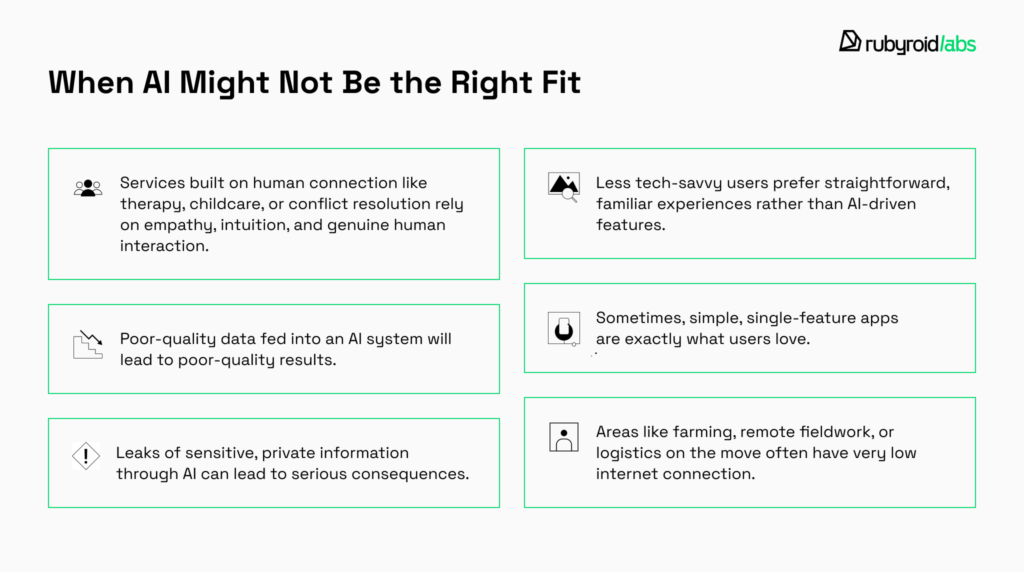
Tips to Keep in Mind Before Investing in AI
Investing in AI can drive impressive results, but it’s smart to enter this new territory with your eyes wide open. Here are some important points to consider, helping you manage potential risks and stay ahead:
Bias and Fairness
AI learns from historical data, and if that data contains biases, the AI could unintentionally reinforce or amplify them. This might lead to unfair treatment or discrimination, harming your customers and your reputation.
Regularly audit your data and models to identify and correct potential biases early.
Regulatory & Ethical Considerations
AI regulations are evolving fast, and ethical expectations are high. Non-compliance with laws or ethical guidelines could lead to severe penalties, fines, or damage to your brand.
Stay updated with regulatory changes, and clearly define ethical guidelines within your company.
Integration & Operational Complexity
Integrating AI into your existing workflow can be complicated. Without careful planning, AI implementation might disrupt operations or fail to deliver the promised value.
Plan carefully for integration, involve stakeholders early, and ensure your team is adequately trained and informed.
With thoughtful and attentive planning, you can achieve meaningful results and a return on investment that truly makes a difference.
Conclusion
Artificial intelligence is a technology that’s already firmly embedded in our daily lives and continues to grow rapidly. Since the high-profile release of ChatGPT 3.5 in 2022, three years have passed, and the field shows no signs of slowing down.
Choosing to implement AI requires careful planning, detailed analysis, and patience to prepare all necessary aspects—from training your team to organizing your data. It’s not a decision you make overnight. Additionally, the returns from AI investment won’t appear immediately; it might take months or even years to see significant ROI.
Nevertheless, a well-chosen AI solution can significantly enhance your project and drive success in industries such as marketing, customer service, e-learning, finance, insurance, and many others. At the same time, be cautious about using AI in areas like psychology or projects involving sensitive or personal data, since they require extra care and attention.
Ultimately, integrating AI successfully involves consulting with AI specialists multiple times. Give yourself enough time to make informed decisions and discuss your project thoroughly with developers. The more knowledge you have, the easier it will be to make the right choice for your business.
